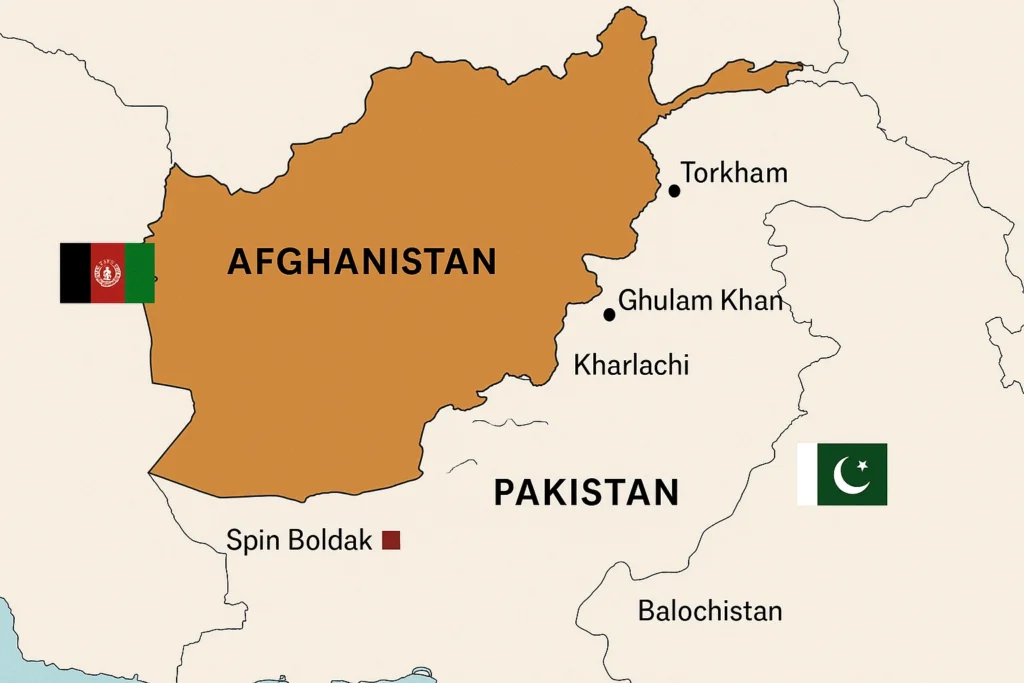Key Highlights
- Videos emerged showing tanks racing through Afghanistan’s Spin Boldak province, with Taliban claiming they were captured Pakistani tanks seized from border confrontations
- Pakistan and Afghanistan agreed to a 48-hour ceasefire starting October 15, 2025, following the deadliest clashes between the neighbors in years
- Pakistan denied Taliban claims about the captured Pakistani tanks, stating the Soviet-era T-55 models shown in videos are not part of its military inventory
Opening Overview
The Afghanistan-Pakistan border witnessed unprecedented tension as videos surfaced showing military tanks racing through the streets of Spin Boldak, with Taliban forces claiming they were captured Pakistani tanks seized during fierce border confrontations in mid-October 2025. Hours before Islamabad and Kabul agreed to a ceasefire, Taliban spokesperson Zabihullah Mujahid declared that Afghan forces had killed “a large number” of Pakistani soldiers, displayed captured Pakistani tanks and weapons, and destroyed multiple military installations along the volatile frontier.
Pakistan swiftly rejected these assertions, with Defence Minister Khawaja Asif stating the captured Pakistani tanks shown in viral social media footage were Soviet-era T-55 models not present in Pakistan’s current military inventory. The claims about captured Pakistani tanks emerged against the backdrop of the worst violence between the two nations since the Taliban returned to power in Kabul in August 2021, forcing both governments to implement a temporary truce to prevent further escalation.
Viral Videos and Conflicting Claims
Social media platforms exploded with footage allegedly showing Taliban forces parading captured Pakistani tanks through Afghanistan’s southeastern Spin Boldak province on October 15, 2025. The videos, which went viral hours before the ceasefire announcement, purportedly depicted captured Pakistani tanks that Taliban forces claimed to have seized from Pakistani military positions during overnight border operations. Taliban spokesperson Zabihullah Mujahid amplified these claims on social platform X, asserting that Afghan forces had not only displayed captured Pakistani tanks but also destroyed Pakistani military installations and inflicted significant casualties on Pakistani soldiers during retaliatory operations.
- Taliban forces allegedly displayed the captured Pakistani tanks in public parades through Spin Boldak streets
- Videos showed what appeared to be Soviet-era T-55 tanks, which have been part of Afghanistan’s military inventory since the 1980s
- Social media users and military analysts questioned the authenticity of Taliban claims regarding the captured Pakistani tanks
- Pakistan’s Defence Minister categorically denied the captured Pakistani tanks belonged to Pakistani forces, suggesting they were purchased “from some junk dealer”
Pakistan’s military establishment moved quickly to discredit the Taliban’s narrative about captured Pakistani tanks, with Defence Minister Khawaja Asif stating during a Geo News interview that the vehicles shown in the videos were not part of Pakistan’s military inventory. Military experts who analyzed the footage identified the captured Pakistani tanks as Soviet-era T-55 models, which have been present in Afghanistan since the Soviet occupation of the 1980s and were never deployed by Pakistan’s armed forces. Despite Pakistan’s denials, the videos of captured Pakistani tanks served to bolster Taliban propaganda claims about their military capabilities against Pakistani forces, even as independent verification of the footage’s authenticity remained elusive.
Pakistani tank was captured by Afghan taliban 🤭@FrontalForce pic.twitter.com/fyM0u3tqC0
— Zabih ullah (@zabih555) October 15, 2025
The 48-Hour Ceasefire Agreement
Pakistan’s Foreign Ministry officially announced on October 15, 2025, that both nations had agreed to implement a 48-hour ceasefire beginning at 6:00 PM Pakistan Standard Time (13:00 GMT), aimed at creating space for diplomatic dialogue to resolve the escalating crisis that included disputes over captured Pakistani tanks. According to Pakistan’s Ministry of Foreign Affairs, the temporary truce was established “at the Taliban regime’s request” following intense negotiations, with both sides committing to “sincere efforts to find a positive resolution to this complex but solvable issue through constructive dialogue”. The ceasefire came after days of devastating cross-border violence that killed dozens of soldiers and civilians on both sides, marking the deadliest confrontation between Pakistan and Afghanistan since 2021.
- The ceasefire took effect at 6:00 PM Pakistan time on October 15, 2025, with both militaries ordered to halt offensive operations
- Pakistan’s Foreign Ministry characterized the truce as being at Afghanistan’s request, while Taliban spokesman Zabihullah Mujahid stated it came at Pakistan’s “insistence”
- Both nations committed to maintaining the ceasefire to allow time for constructive diplomatic engagement
- The agreement initially covered 48 hours but was later extended to facilitate peace talks in Doha, Qatar
Taliban spokesperson Zabihullah Mujahid confirmed Kabul had directed its forces to observe the ceasefire, while emphasizing that Afghanistan reserved the right to respond if Pakistan violated the agreement. The conflicting narratives about which side requested the ceasefire reflected the broader tensions and mutual distrust characterizing Afghanistan-Pakistan relations, with each government seeking to portray itself as the more reasonable party committed to de-escalation. Despite the mutual accusations about captured Pakistani tanks and other disputed claims, both sides recognized that continued fighting risked spiraling into a broader regional conflict, prompting the temporary cessation of hostilities.
Deadly Border Clashes
The border confrontations that precipitated the ceasefire agreement represented the most intense fighting between Afghanistan and Pakistan in years, with both sides reporting significant military and civilian casualties. Afghan Taliban forces launched coordinated attacks on multiple Pakistani military posts along the Afghanistan-Pakistan border on the night of October 11-12, 2025, reportedly in retaliation for suspected Pakistani airstrikes targeting militant hideouts in Afghan territory. Afghanistan’s Defense Ministry claimed its forces killed 58 Pakistani soldiers during overnight border operations, while Pakistan’s military stated it killed more than 200 Afghan fighters, with 23 Pakistani soldiers dead and 29 wounded.
- Afghanistan claimed its forces killed 58 Pakistani soldiers and captured 19 border posts during overnight operations
- Pakistan reported killing over 200 Taliban and affiliated fighters while losing 23 soldiers with 29 wounded
- Civilian casualties mounted in border areas, with at least 15 civilians killed and over 100 wounded in Spin Boldak alone
- Independent verification of casualty figures remained difficult due to restricted access to conflict zones
The fiercest battles occurred in and around Spin Boldak, a strategic border district connecting Afghanistan’s Kandahar province with Pakistan’s Balochistan region, where residents fled their homes as heavy weapons fire and artillery exchanges devastated civilian infrastructure. Reports from Italian humanitarian organization EMERGENCY, which operates a surgical center in Kabul, indicated they received 40 wounded patients and five dead following explosions in the Afghan capital, with casualties suffering “shrapnel wounds, blunt force trauma and burns”.
Pakistan’s Foreign Ministry accused the Afghan Taliban, along with the Pakistani Taliban (TTP) and other militant groups, of “unwarranted aggression” along the Pakistan-Afghanistan border during the night of October 11-12 and again on October 14-15, 2025. The escalation prompted closure of all major border crossings, including Torkham, Spin Boldak, Ghulam Khan, Angoor Adda, and Kharlachi, halting cross-border trade and trapping thousands of migrants and travelers on both sides.

Root Causes
The primary catalyst for the border violence stems from Pakistan’s accusations that Afghanistan provides safe haven to the Tehreek-e-Taliban Pakistan (TTP), also known as the Pakistani Taliban, which has intensified its insurgent campaign against Pakistani security forces since the Afghan Taliban returned to power in 2021.
Pakistan’s military establishment maintains that the TTP, along with the Balochistan Liberation Army (BLA) and the Islamic State Khorasan Province (ISKP), operates freely from Afghan territory, planning and executing attacks that have killed hundreds of Pakistani security personnel over the past several years. According to data from the Armed Conflict Location and Event Data Project (ACLED), the TTP conducted at least 600 attacks against Pakistani security forces in the year preceding October 2025, with activity levels in 2025 already surpassing the total for 2024.
- The TTP has conducted over 600 attacks against Pakistani security forces in the past year, according to ACLED data
- Pakistan estimates the TTP maintains between 30,000 to 35,000 fighters operating primarily from Afghan territory
- Pakistan initiated airstrikes on October 9, 2025, targeting TTP hideouts in Kabul, Khost, Jalalabad, and Paktika
- The Afghan Taliban faces a dilemma as many of its fighters share ethnic and ideological ties with the TTP
The TTP emerged in 2007 during the U.S.-led “war on terror” as an umbrella organization of various militant factions opposing the Pakistani state, advocating for strict Islamic law implementation and the release of detained members. Pakistan’s military operations in the former Federally Administered Tribal Areas forced many TTP fighters to flee across the border into Afghanistan, where they found sanctuary under successive Afghan governments and later under Taliban rule.
The Afghan Taliban’s reluctance to crack down on the TTP reflects complex tribal affiliations, shared Pashtun ethnicity, and ideological sympathies between the two groups, despite the Afghan Taliban’s official stance of preventing Afghan soil from being used for attacks against neighboring countries. Pakistan’s October 9, 2025, airstrikes specifically targeted TTP leader Noor Wali Mehsud in Kabul’s Abdul Haq Square, though the TTP later released an unverified audio recording suggesting Mehsud survived the assassination attempt.
(3/6) Civilian suffering & border chaos:
— Allen Hampton (@Hamp_Allen) October 16, 2025
The ceasefire came only after days of carnage.
Thousands fled their homes in Spin Boldak, Paktika, and Kunar. Major crossings, Chaman and Torkham, are sealed, freezing trade worth millions daily.
The Afghan Red Crescent warns of “mass… pic.twitter.com/5TiFiqGB0n
Closing Assessment
The controversy surrounding captured Pakistani tanks and the subsequent 48-hour ceasefire underscore the fragile and deteriorating relationship between Afghanistan and Pakistan, two nations once considered close allies now locked in a dangerous cycle of military confrontation. While Pakistan categorically denied Taliban claims about the captured Pakistani tanks, dismissing the Soviet-era tanks as Afghan inventory rather than seized Pakistani equipment, the propaganda value of such assertions demonstrates how information warfare supplements kinetic operations along this contested frontier.
The extension of the ceasefire and scheduled peace talks in Doha, Qatar, involving Pakistan’s Defence Minister Khawaja Asif and Afghan Defence Minister Mullah Muhammad Yaqoob, offer a diplomatic pathway to de-escalation, though underlying issues regarding TTP sanctuaries and cross-border militancy remain unresolved. The temporary reopening of the Spin Boldak-Chaman border crossing for stranded migrants, while maintaining trade restrictions, reflects the humanitarian pressures both governments face as border communities bear the brunt of this escalating conflict. As regional powers including China, Iran, and Russia urge both sides toward restraint, the fundamental question remains whether Pakistan and Afghanistan can establish sustainable mechanisms to address mutual security concerns without resorting to military confrontation that threatens regional stability.


